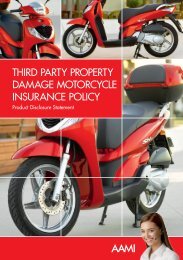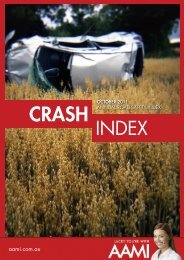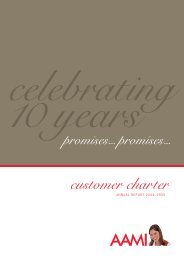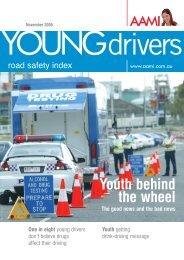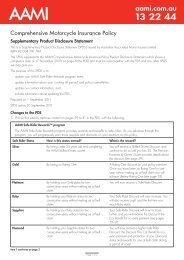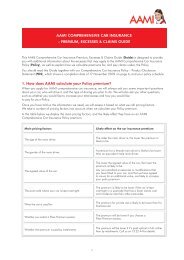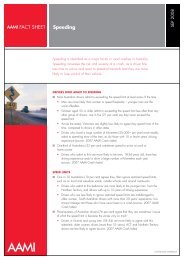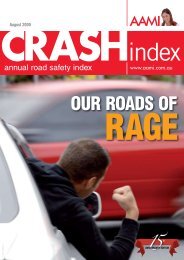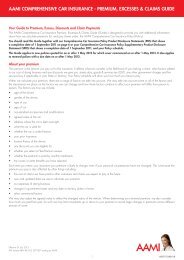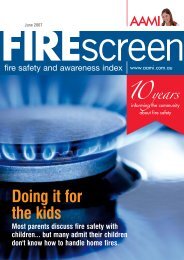You also want an ePaper? Increase the reach of your titles
YUMPU automatically turns print PDFs into web optimized ePapers that Google loves.
10<strong>AAMI</strong> CR SH INDEXTenth annual road safety report – October <strong>2004</strong>Mobile phone hazard:one-quarter ofmotorists textand driveDrivers say our roadsbecoming moreaggressivePicture: Matthew Munro
Shopping centre car parks,traffic lights – hotspots for driver aggressionCauses of ‘rage’Four in 10 motorists (43 per cent) admit tosubjecting other drivers to ‘road rage’. Almostone-third (29 per cent) of them said they didso because the other driver cut them off,10 per cent said the driver changed lanesdangerously, 8 per cent said the driver failedto indicate or didn’t indicate in time,9 per cent claimed the driver did not pullaway from the traffic lights and 7 per centsaid the person was driving too slowly.Younger drivers and people who drove morekilometres each year were most likely to reactto other motorists and exhibit anti-socialdriving tendencies.Despite the high number of motorists whoadmitted to these tendencies, only one inseven drivers (15 per cent) describedthemselves as ‘impatient’ on the road.Furthermore, half of all motorists (48 per cent)said they felt they were better drivers thanmost others.Car parks singled outThirty-nine percent of drivers singled outshopping centre car parks as the hotspotsfor driver aggression. Queenslanders, SouthAustralians and four-wheel-drive ownerswere more likely to feel this way. One-thirdof drivers (33 per cent) said they felt trafficlights were the worst places for aggression.Driving distractionsDespite heavy campaigning against the use ofhand-held mobile phones while driving, one infive motorists (18 per cent) said they regularlyuse their mobile phone without a hands-freekit when driving. One-quarter of motoristsalso said they have sent or read a textmessage while driving. Half of all motorists(50 per cent) said they have used their mobilephone without a hands-free kit at some point.Drivers appear to be cynical about hands-freemobile kits. Seven in 10 drivers (70 per cent)feel hands-free mobiles are as distracting asnormal mobiles when driving.Car audio systems were also highlighted asdriver distractions: almost half of all motorists(45 per cent) admitted they have lostconcentration while changing a CD, tapeor the radio station while driving.Drink-driving menaceAlthough most drivers displayed responsibleattitudes towards drink-driving, a minoritycontinue to flout the law. One in seven(15 per cent) said they do not leave their carat home when planning to have a few drinks.One in eight drivers (12 per cent) said thateven when they only intend to have one ortwo drinks because they are driving, theysometimes have more than they should.A smaller percentage still (9 per cent)believes it’s OK for them to drive after afew drinks as long as they feel capable.Encouragingly, this figure is the lowest it hasbeen in the past five years. Over all, one-thirdof drivers (37 per cent) say they have drivenwhen they were probably over the drink-drivelimit at some point.Mixed results for lowerspeed limitsThe introduction of 50 km/h limits inresidential areas and 40 km/h limits aroundschools seems to be having a positive effect.Three-quarters of motorists (72 per cent)agree that lower speed limits in city areashave influenced them to drive slower.Despite strong enforcement of speed limitsthroughout Australia, however, one-quarter(24 per cent) of motorists think there is littlechance they will be caught if they speed.This figure has increased by nine percentagepoints since 2000. One-third of motorists(34 per cent) also said that they wouldspeed if they were certain they wouldnot be caught.Eight in 10 people (83 per cent) said theyhave driven more than 10 km/h over thespeed limit at some point. Nine in 10motorists (87 per cent) said they exceed thespeed limit at least some of the time. Thirtyper cent of drivers said they believedanywhere from 1– 5 km/h over the speedlimit constituted speeding.One in five motorists (21 per cent) said theywere more likely to speed on country roadsbecause there is less chance of being caught.One-third of motorists (34 per cent) said theysometimes speed to get to work or homesooner. Just five per cent said they speedall the time.Distrust and cynicism forspeed camerasDeservedly or not, half of motorists(47 per cent) say they do not trust theaccuracy of speed cameras. Apart from theirperceived lack of accuracy, motorists are alsocynical about their relationship with broaderroad safety strategy. More than half ofmotorists (53 per cent) believe harsherdemerit points would be a fairer and moreeffective deterrent to speeding than fines.Even more motorists (56 per cent) believespeeding fines are mainly used as a source ofrevenue than a way to discourage speeding.Sharing the roadAggression and safety on the roads are notthe only causes for concern among motorists.Eight in 10 people (82 per cent) believemotorists could make more effort to makethe roads safer for cyclists and pedestrians.Not surprisingly, four in 10 people(42 per cent) say aggressive drivers putthem off walking or cycling.Three-quarters of drivers (74 per cent) saidthey often see trucks driving aggressively orbreaking the speed limit, however, motorbikeriders and cyclists were voted the biggest risktakers on the roads (59 per cent).Fatigue-drivingmessage ignoredDespite concerted efforts to raise awarenessof the dangers of driving while tired, halfof motorists (48 per cent) agreed thatsometimes they drive tired even thoughthey know they should not. One-third ofdrivers (32 per cent) said that if they weretired while driving, they would not stop totake a powernap. In the past 12 months,5 per cent of motorists said they hadmomentarily fallen asleep at the wheel.However, three-quarters of drivers(75 per cent) said that if driving for morethan a few hours, they would plan when andwhere to stop for breaks. Of those driverswho experienced a crash in the last year, twoper cent said fatigue had contributed to it
30 per cent of all crashes occurred after noon on a FridaySydney leads nation in car accident numbersShocking ads won’t workTwo-thirds of drivers (66 per cent) said theydo not believe the explicit anti-speedingadvertisements change drivers’ behaviour.Most drivers (85 per cent) said they wouldlike to see a greater focus on safety rather1514.518.316.5<strong>Crash</strong> hotspots15.214.8 14.713.6than speed in vehicle advertising, the sameproportion as last year.10Young men again voted worston the roadMen under 25 years of age were voted theworst drivers by all sectors of the community– including themselves. Half of all motorists(50 per cent) voted them the worst on theroad, significantly higher than the next mostdisliked group, women under 25 whoreceived just 16 per cent of the vote.5%National Sydney Brisbane Melbourne Adelaide Hobart ACT<strong>Crash</strong>es and law breakingThree in 10 people (28 per cent) haveexperienced a crash while driving. One in 10had experienced a crash in the last 12months. Lack of concentration was cited asthe main cause of those accidents and beingdistracted by something in the vehicle alsorated highly as a cause of crashes. Seven in10 people (71 per cent) said they had beenfined for a traffic infringement at some timein their lives. Of those that occurred in thepast 12 months, 11 per cent had been finedfor speeding. Twelve per cent of driversadmitted their driver licence had beensuspended or cancelled for a trafficinfringement at some point. Drink-drivingand speeding were the two main reasonscited for licence suspensions or cancellationsFriday afternoon: danger timeThe familiar pattern of accident danger timescontinued throughout <strong>2004</strong>. <strong>AAMI</strong>’s claimsstatistics showed that Friday afternoon wasthe worst time for crashes. Nationally,17 per cent of crashes occurred on a Fridayand 30 per cent of all crashes (where thecrash time was known) occurred betweenthe hours of midday and 4 pm.The crashes that occurred between the hoursof midnight and 4 am were the most costlyon average. These crashes were 1.5 timesmore costly than the next most costly period:8 pm-midnight.Sydney: the crash hot spotNationally, the incidence rate of crashesincreased only slightly. ACT recorded thelowest incidence rate for crashes, andSydney the highest.Type of accidentNose-to-tail accidentsmost commonMost accidents are minor in nature –collisions with stationary object or vehicles,or nose-to-tail accidents accounted foralmost 60 per cent of <strong>AAMI</strong>’s crashclaims in 2003-04.Failing to give way accounted for one in fiveaccident claims, while rollovers, head-oncollisions and loss of control accidents werethe least common, accounting for only3 per cent of claims in the past 12 months.Percentage of all accidents30% Collision with stationary object/car27% Hit in rear22% Fail to yield right of way15% Damaged while parked3% Hit head on/roll over/lost control3% Hit animal/pedestrian/cyclist
‘Slow down’ is a tough message to sell by Con Stavros, Senior Lecturer in Marketing, RMIT UniversityThe <strong>2004</strong> <strong>AAMI</strong> <strong>Crash</strong> <strong>Index</strong> hassome bad news for advertisers.While the message to car advertisersis: show us safety, not speed, themessage to government bodies is:stop trying to shock us intoslowing down.The Victorian Government, despitegreat success, must decide nowwhether its shock campaigns havereached their use-by date and if anew approach is needed.Governments in other States face a difficultdecision: to abandon their relatively newadvertising campaigns or continue them despitethe general community’s belief that theadvertisements will not work, inthe hope that community attitudeswill change long term.This issue of balancing short – andlong-term expectations is one thatmarketers must face all the time,but it takes on greater urgencywhen lives are on the line.As for car manufacturers,most respondents (85 per cent)would like to see car advertisingwith a greater focus on safety rather than speed.Selling cars is a competitive and challengingbusiness; perhaps more manufacturers need tobreak away from the emotion-driven pack andreturn to a rational approach.The general unhappiness of respondents to carmanufacturers’ and government communicationtechniques may be traced back to greaterscepticism of advertising itself. Bombarded bythousands of messages every day, consumersare increasingly filtering out most messagesand are highly cynical and sceptical about whatthey are being told.Changing attitudes through advertising andpromotion is not a short-term job. It takes time,patience and the willingness to move in small steps.Telling people to slow down in a rational, statisticalmanner may seem like a good approach – butunfortunately, an audience’s tendency to alwaysassociate negative events with ‘other people’ willovershadow the message.The human impactby Darren Perryman, Unit Manager, Victoria State Emergency Service Torquay and Assessing Manager, <strong>AAMI</strong>I have been employed by <strong>AAMI</strong> for 16 years andam currently Assessing Manager for Victoria.Having assessed some 12,000 vehicles myself,it’s fair to say I’ve seen more than my share ofwrecked vehicles and I have gained a humanperspective on crashes through my involvementwith the Victoria State Emergency Service (SES)as a volunteer.As an SES volunteer, I’ve attended approximately40 road accident rescues – these are usuallysevere crashes because we are called only whenoccupants of the vehicle are trapped. Sadly, therehave been a number of fatalities among them.Sometimes the crashes involvemultiple vehicles, others are singlevehiclecollisions with stationeryobjects, such as a tree or a pole.In the crashes I’ve attended,alcohol, speeding and fatigue, or acombination of those factors, appearto be the most common causes.Often, the victims are youngpeople and many of them weren’twearing seatbelts, which makestheir injuries so much more severe.<strong>AAMI</strong>’s findings that one in 20 people don’t alwayswear a seatbelt and that one in20 sometimes have more peoplein their cars than seatbelts aredefinite causes for concern. Oftenpeople fail to wear seatbelts whenthey have been drinking and theyonly have a short distance to travel.Sadly, many of these fatalities andinjuries could have been avoided,if only people had taken morecare. You would only have toattend one road accident rescue with me, andyou’d never take these kinds of risks.Driving dangers by John S. Cheetham, Consulting PsychologistWe live with risk as part of our useof a motor vehicle, but much of theincreased danger that we face onthe road comes from carelessattitudes and irresponsible behaviour.The high proportion of people whohave been subjected to some form ofroad rage suggests that we are boththe victims and the perpetrators ofinappropriate behaviour on our roads.The message that all drivers need toembrace is: feelings are not the problem, howwe choose to express them is the core issue.When we act on our feelings without thinking,selfishly intent on ‘getting back’ at some perceivedidiot, we place ourselves, our passengers and otherroad users at risk. Responding appropriately to thechallenges we face on our roads requires emotionalmaturity – something that we hope all drivers willtake with them into the driver’s seat.Another major new finding in this <strong>Index</strong> is ourunsafe use of technology,including a propensity to‘text’ and talk on mobilephones while driving.Either by being distracted by amobile phone while in the car(24 per cent) or by frequentlyusing a mobile phone withouta hands-free kit while driving(18 per cent), we are acceleratingour risk of causing an accident.Interestingly, international research shows thatmotorists are more accident-prone and slowerto react when they talk on a mobile phoneeven if it is hands-free. The reason for increaseddanger from any mobile phone use while drivingis known as ‘inattention blindness’.Even though a driver can be concentrating visuallywhile talking, they fail to ‘see’ what they arelooking at, because their mind’s attention is directedelsewhere and their reaction times are delayed.We all know from our driving experience that afraction of a second can get us out of danger –or place us in danger. The consequences ofdanger being mishandled are enormous.The <strong>2004</strong> <strong>AAMI</strong> <strong>Crash</strong> <strong>Index</strong> sends all driverstwo clear messages:• Take responsibility for your feelings and thinkbefore you act foolishly or recklessly.• Understand that talking on a mobile phonewhilst driving is more dangerous than speakingto a passenger.Never attempt to send/read a text message whiledriving and don’t be lulled into a belief that talkingon a mobile phone is no different to speaking to apassenger in a car. The difference is that yourpassenger can see what is happening on the roadahead and will adjust their conversation accordingly.The person on the other end of your phone can donothing to mitigate your distraction.As drivers, we all need to accept and manage riskand reject danger.
10<strong>AAMI</strong> CR SH INDEXTentips forgetting there safely1. Make sure you’ve had a good night’s sleep before a long drive and don’t driveat times you would normally sleep2. Take a break out of the vehicle at least every 90 minutes – use the Driver Reviversites that operate along many tourist routes at peak times and the rest areassituated along many major routes3. Share the driving when possible4. Obey all road signs5. Allow extra travel time and don’t speed6. Never drink alcohol – even small quantities – before or during long trips7. Don’t drive while taking medication that may affect your driving – check labelson your medication and if in doubt, ask your doctor8. Minimise in-car distractions such as mobile phones – you don’t have to answera call or message immediately, or if you must, pull over somewhere safe.9. Spare a thought for the people sitting alongside you, in front or behind.Their needs to get to their destination safely are important to them.10. Reacting to someone else’s aggression will only make the situation worse – beinghuman means that we all make mistakes. Forgive yourself and forgive others.<strong>AAMI</strong> Skilled Drivers program<strong>AAMI</strong> has provided a young driver education program for more than 20 years.The <strong>AAMI</strong> Skilled Drivers program is designed to educate participants about safeand responsible driving behaviour. It is available free of charge to licensed driversup to the age of 25 who hold an <strong>AAMI</strong> comprehensive car insurance policy in theirown name, or whose parents have a comprehensive motor vehicle policy. Otherscan undertake the course for $165. The course is taught by expert trainers fromthe Driver Education Centre of Australia. For more information call 13 22 44.132244www.aami.com.auvPrinted on recycled paperP0111P104



